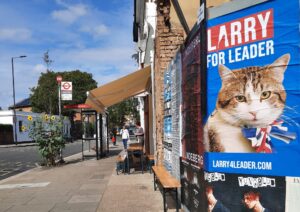How depressing to see the Prime Minster spending “quality time” with Lachlan Murdoch, at a time when Murdoch is trying to bully the newsletter publisher, Crikey into submission. The description of Crikey as a minnow is to underestimate its clout and the intention of Eric Beecher to confront what he perceives as the malign influence of the Murdochs.

It is important to place Beecher in context, and while his own bio is scant, this quote from the Public Interest Journalism Initiative provides a summary of his early achievements. Beecher started in newspapers as a journalist on The Age in Melbourne and later worked at The Sunday Times and The Observer in London and The Washington Post in the US. In 1984, at age 33, he became the youngest-ever editor of the Sydney Morning Herald and in 1987 was appointed Editor-in-Chief of the Herald and Weekly Times newspaper group.
He has spent a large part of his later life as the pamphleteer, railing against the privileged plutocracy, which has grown under cover of globalisation and the so-called information revolution. He has explored alliances with other writers with a like attitude.
Lachlan Murdoch is targeting him in the defamation jurisdiction on Earth most sympathetic to the complainant – namely NSW. Nevertheless, Beecher has taken the decision after initially retracting the offending comment to challenge the Murdoch Empire of “alternative facts”. As Beecher has commented, any morality in journalism has been sacrificed in the pursuit of financial profit, and Murdoch, once the supporter of Whitlam and the Republic, has given over to a son without any connection to Australia, apart from a father who has long deserted his citizenship, again in the pursuit of profit.
Thus, it is tedious to see the Prime Minister giving the Murdochs the normal vassal symbolism of going cap in hand to them. When will they learn? Remember, Rudd was entrapped by a Murdoch operative in a New York strip club. Prime Minister, have you forgotten the disgusting behaviour of Murdoch in Great Britain, where yon Rupert almost apologised by closing down the “News of the World”? But then it was the other son James in the firing line, rather than Lachlan.
I’m not surprised that Marles joined in the pilgrimage to Compostela de St Rupert, given his common Geelong Grammar School heritage with Rupert. Marles, as with Murdoch, had an elderly father, and both his parents were high achievers. So, both “slumming” in a working class electorate and rubbing shoulder with the establishment is a recurrent behavioural pattern among some of the Victorian Labor party private school elite.
But really, Penny Wong! Or were you just practising dealing with some of the unsavoury types lurking around the world in some of the foreign affairs portfolios?
Presumably to demonstrate neutrality in the ongoing stoush, the Prime Minister should visit Crikey and break bread with Eric Beecher and his crew in a less plush setting but in keeping with his electorate’s wish.
Finally, yes, we have contributed to Crikey’s defence.
St Kilda
I have been reading about St Kilda.
Not the beach suburb of Melbourne, although I must admit that I was surprised of an association; I’ll come back to this later.
St Kilda was a few rocks stranded in the Northern Atlantic Ocean about 60 km from the Outer Hebrides and where, for centuries, a small group of hardy settlers subsisted. Until the nineteenth century, they lived a very isolated existence with the occasional ship calling carrying salt, iron and timber for which they traded cows, sheep, feathers and grain.
It was a hard life, living in such a state without money, where the whole population gathered as their local council, with strict observance of the Sabbath with Christianity interwoven with pagan practices, where the infant death rate was greater than 50 per cent because of neonatal tetanus, which is terrifyingly described.
The islanders raised sheep and cattle and grew some crops, barley and potatoes. They did not fish, but rather raided the bird nests which were clustered in the steep cliffs which ringed the islands.

The largest and inhabited island was Hirta and thus the inhabitants were more commonly called Hirtans rather than Kildans. The link with Melbourne is that some of the islanders apparently found their way to Melbourne. St Kilda beach in Melbourne may have sea birds on its sands, but that was the only similarity. The immigrants would have missed their roasted puffin, but surely cooking a puffin reminds one of the old recipes about cooking a galah with a stone.
Collecting eggs and birds from the cliff face was a Hirtan skill, which even to today’s rock climbers would have presented a challenge, as the ropes they used were very rudimentary, with much jollification while this hazardous operation was happening.
In the nineteenth century, St Kilda became a tourist spot, even though landing on the island presented problems, especially when the weather was bad. There was a post office where postcards could be stamped. Photographs of the islanders became popular. Paradoxically, the standard of living rose, as shown in contemporary photographs of the improvement in the housing, but the attrition of a population, now exposed to the mainland “delights” increasingly losing their previous self-sufficiency, accelerated.
The final paragraph of the description of the Hirtans in Shadowlands is evocative. By 1930, the population was reduced to 36.
“…in the dying days of August 1930, the final postcard was sent. Its message, from a tourist called Freda, said, just “Last Greetings from St Kilda.” Then the post office was shut forever. The final service was held in the church and bowed by sorrow, the islanders rounded up their dogs, those indomitable hunters and guardians, tied weights around their necks, placed them in sacks, and dropped them from the pier, looking sorrowfully on as the yelping bundles sank beneath the waves. They returned to their houses and waited for HMS Harebell.
And up on the stacks of Boreray, from their nests in the cliffs, the birds rejoiced.”
It is an example of the problem of civilisation intruding on a community which has achieved a fragile ecological balance and then, over time, from being endangered they are rendered extinct. Our forefathers characterised the Australian Aboriginal people as remnants of the Stone Age whereas they had developed a very complex hunter/gatherer society, but unlike the Hirtans they had a far bigger canvas upon which to work. Nevertheless, what have we learnt from the Hirtans, especially as with the Australian Aboriginals, there was no written language – not even an ogham?
Same Old Rubbish?
I have been a supporter of the Essendon Football Club for most of my life. It was because of the Doust family, who lived on the corner; and then after WWII they went back to Britain, leaving me with a black and red scarf. We lived nowhere near Essendon, and so it was quite a trip across the city to watch them play. The Victorian Football League (VFL) then was essentially composed of inner suburbs extending west and north. The only team in the eastern suburbs was Hawthorn, and when I was small, its team was a “basket case”.
Essendon did not conform to the original teams when in 1897 the VFL was formed. Essendon was not an inner working class suburb. Yet Australian Rules was essentially a working person’s game, despite having a posh beginning as a game between an Anglican and a Presbyterian private school.
Many of the clubs were both Irish and Roman Catholic, none more so than Collingwood in the era when John Wren virtually owned the club. Essendon was not Roman Catholic – far from it. But the nuances of this history were lost on one small boy, even the fact that Essendon once played their games in East Melbourne where the railway yards now stand and they were nicknamed “the Same Old”.
By the time I became a supporter, the team was located at Windy Hill, high on the hill in Essendon where the gales blew. In winter it was a place for the frozen spectator, even rugged up and with the obligatory Thermos in hand; and because the suburb Essendon had become the location of Melbourne’s airport, the football club adopted the nickname of the “Bombers” in 1940.
It was a different time with the VFL progenitor, Victorian Football Association (VFA), having many of its teams in the eastern, south-eastern and southern Clubs still active. Oakleigh, nicknamed the Devils even though they wore gold and purple colours, just down the road was my club, but I was never as addicted to Oakleigh in the same way as I was to Essendon.
This long introduction is to say that most of my life has been consumed in my support of Essendon, even at one time being a paid-up Essendonian. However, that changed when the game became an exercise in keepings-off and Essendon relinquished its Windy Hill home.
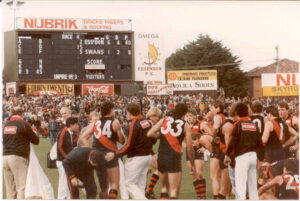
Sport at the top level is now a moneyed game driven by TV rights. There is also a stadium fetish, to ensure that the pampered few are spared the rigours of winter with access to glass boxes awash with alcohol. The players from teenage years are moved around as well-paid commodities without, in most cases, any deep-seated loyalties. After all, being doled out in a draft means that these players are separated from their hearth and home. And that gnaws away at the special nature of the Game loyalties.
Curiously, the game is reverting to the original game where there seemed to be limitless players, running on and off in a blur, to maintain the momentum of the game, keepings off, scragging; little men in yellow running around making arbitrary decisions so they can keep up with a game, which is driven by the manic desire of those who run the game to make it faster and faster. The only difference between the original game in 1958, which perhaps should be introduced, is running among the gum trees in Yarra Park and the length of the playing arena when rules as today were arbitrary or non-existent – and of course the little yellow officials.
However, there is a veneer of corporate civilisation. As somebody wrote about the Essendon worship of bright and shiny baubles “Walking up the concrete steps, Essendon’s headquarters feels like a corporation. The generic nature of the massive building continues inside where it becomes immediately clear the home of this historically great football club – which has not been anywhere near great since it moved to Tullamarine – has no heart.
That is my problem – once a fanatical supporter who imparted the same spirit to my sons and then they to most of the grandchildren. But then only one of these six was alive – just – when Essendon won its last premiership in 2000. My heart has gone – I no longer care.
Maybe a flicker of nostalgia when I read about Michael Hurley’s complete loyalty to the club. (pictured)

The AFL has a heritage round, but what is meant by heritage? True heritage would be playing twenty a side – eighteen on the field with two emergencies, which came on as replacements and were not interchangeable. Yet that rule only operated from 1946 until 1978 when the interchange rule was introduced. The longest time the rules of the game have not been changed was nine years between 1877 and 1886. Now, there is more year-to-year fiddling with the rules than in a Bullamakanka bush band.
Then see how the spectators would enjoy it. The grounds are more uniform than in the past. When playing at Hawthorn, you were on a compressed ground wedged against the railway lines – and with the right conditions the full back kicking out, if accurate enough, could kick a goal at the other. I repeat “if the conditions were right”. Oh, for the suburban grounds that had character.
Now, what an exercise in sterility, but the AFL is now politically correct. Gillon McLachlan, scion of the South Australian Establishment, you have left your legacy – you have pasteurised the game behind pay walls. Well done.
What the Butler saw
The Strengthening Medicare Taskforce is bringing together Australia’s health policy leaders. The diverse membership has been drawn from across the health professions, and includes consumer, rural and regional and Aboriginal and Torres Strait Islander representatives.
The Taskforce will work to deliver concrete results through its recommendations, including:
- Improved patient access to general practice, including after-hours.
- Improved patient access to GP-led multidisciplinary team care, including nursing and allied health.
- Greater patient affordability.
- Better management of ongoing health conditions including chronic conditions.
- Decreased pressure on hospitals.
Here we go again. The Same Old!
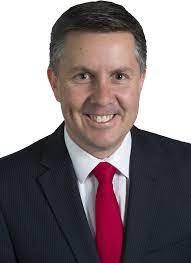
Mark Butler, a lawyer and union official prior to being elected to Parliament, under Rudd had an exposure to matters relating to Health, in various parliamentary secretary and ministerial positions between 2009 and 2013. He had been Shadow Minister for Health since January 2021
Unlike another South Australian, Neil Blewett, who maintained continuity in the portfolio whether in Opposition or Government to became one of the best Ministers of Health, when the Labor Party went into Opposition, Butler was handed the shadow environmental portfolio by the then Opposition Leader, Bill Shorten. The Health shadow portfolio was passed to Catherine King. After the 2019 election, the shadow Health Ministry was held by Chris Bowen, until it was passed back to Mark Butler. The Health portfolio seems to have been in the “pass the parcel” category among the Labor gentry.
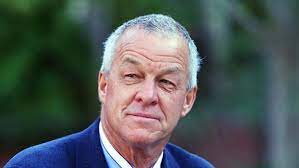
One of the prerequisites for the Health portfolio incumbent is that unless one learns the language of Health, it condemns you to being at the whim of translators. Blewett as a linguist was fluent in Health, and he also had a bunch of public servants who had served in health matters for a considerable period, and while they were not necessarily health professionals, they were more or less fluent in Health. Guys like Alan Bansemer and Bernie MacKay.
A 17 member committee is doomed to failure as anything but a megaphone, given that allows every member an average of 3.5 minutes an hour to speak. Also the bigger the Committee the more unwieldly, although technology allows for everybody not to be in same room for a meeting; however, that introduces the trickiness of the membership being in isolated cells, without any meaningful interaction. But maybe that is a deliberate ploy. I have faced public service running interference and have dealt with it mostly – without winning any popularity polls.
Scanning the list of Butler’s Committee, the only one with any decent corporate memory is Stephen Duckett; like all of us who have been in the health sector for as long or, in my case, longer than him we have our own set of biases. Duckett sure has his, and his bias against private practice is well-known. He is sure to raise salaried practice and capitation as alternatives; but Medicare has served Australia well, even under conservative governments where it is always allowed to decay. Added to this the central agencies hate uncapped programs as Medicare has been.
My problem with the medical representation is that each is there because they have been elected as distinguished members of one of the many tribes of medical graduates, not as experts in health economics and policy. To them, reforming the health system is not a full time pursuit, but a task force gives them all the opportunity to whinge, and in a couple of years these office holders are gone.
The only medical graduate on the committee, a former President of the AMA with some experience of the vicissitudes of Medicare, is Hambleton. He does not fill me with any confidence because once when I asked why the AMA had ceased being deeply involved in establishing doctor’s incomes, he seemed confused about the value of the bilateral Medicare Enquiries between the AMA and the Federal Government last held in 1984.
Looking down the list it seems that the aim is to include every player in the provision of primary care and a wish list of aims without any means of achieving it. Thus presumably, the Department will prepare a series of working papers – a variation on the Jenny Macklin National Health Strategy Initiative where she was asked to review Australia’s existing system, which produced a series of discussion papers of varying quality. That task force was disbanded in 1993, without any discernible effect on the health system. My involvement goes back to listening to Gough Whitlam expounding on health reform in 1969 at the time of the Nimmo inquiry, when the genius of John Deeble and, to a lesser extent, Dick Scotton provided the intellectual capital for both Medibank and Medicare.
The crux of the primary care problem is that despite all the talk about professions working together, it just does not happen spontaneously. I am a patient in a very good general practice, with very competent medical and nursing staff. They have their tasks and they don’t spend their time in formal training in how to get along. As a patient, I want to be able to converse with my general practitioner and yet realise I have a limited time to do so. Yet despite its caring profile, this long term traditional suburban general practice has been absorbed into the corporate world, and if it were not profitable, you could bet your bottom dollar that this world would not be there. This presents a bit of a paradox. Substantial investment on the one hand; crying poor on the other.
The other variable is general practices now closing off appointments for new patients, which effectively caps throughput. Given that Medicare is uncapped – and the rule of thumb is to maximum daily limits for doctor – namely seeing 80 patients a day for 20 days a year or 30 telehealth consultations for the same period a year, otherwise any more will attract a reference to the Professional Services Review Committee. That is the only comment on optimal throughput – two extreme positions. The Committee should address optimal throughput.
Given that the public has been used to bulk billing in general practice, I can now ask a question: “What is general practice?” and then ask, “what is the most cost-effective way to deliver general practice?”
My premise is that general practice is heterogeneous. Yet it conforms to certain rules. For instance, at least three doctors are required if the practice provides a 24-hour service. Yet how many practices exist as standalone services providing such a service? In rural areas in the small towns such a service is problematic, but general practitioners there do have a local hospital to back them up. I have no idea what the “urgent centre” proposed by NSW and Victoria is; and where does the staff come from – Mongolia?
In any question of general practice, one must ask the question of what level of coverage by general practice yields the most effective return. The fact that the so-called 24 hours clinic or general practice attached to urban hospitals has not become standard suggests this is a work pattern unacceptable to the majority of the general practice workforce, notwithstanding that its income is underwritten by government.
From a question of what is general practice, and the most cost effective organisation of same, then it becomes a cost accounting exercise. The best cost accounting depends on ensuring that all the assumptions underpinning the process are clear. There are times when approximations will be made; and it is the test of any good cost accountant to know when to approximate. After all, if one waits for a complete census of any population when 90 per cent will provide a useful approximation and if the information can be obtained in a reasonable time, then delays are avoided that otherwise can render the data of limited use.
The problem is that the advice provided by cost accounting is ignored by government, because it is often inconvenient. We once showed that the most effective radiation oncology practice was one based on three linear accelerators at any one site. What happened was the States bent to political pressure and scattered one machine facilities across its jurisdiction; as well as being uneconomic, these facilities had difficulty maintaining staff.
In the end, once the true costs are known, then it can be discussed what should be the professional cost of the practice, the expected income of the general practitioner, which is subsidised through fee for Medicare benefit and what can be gained by additional charges that the patient has to find. This figure is complicated by the corporatisation of general practice. After all, general practitioners can charge what they believe is fair and reasonable. What does their corporate boss want to charge?
The Federal government provides a patient benefit not a doctor’s fee. The patient benefit is constitutionally valid; but setting fees is not. The Australian voters in the 1973 referendum rejected Federal control on prices and income.
And there you are. Answers are gained, and the 17 member committee can deal in facts adorned by assumption rather than opinion warped by bias and, I hesitate to say, “enlightened self interest”.
Where fantasy meets reality
In the Boston Globe, Stephanie Ebert runs a regular opinion piece chronicling what is happening due to the Supreme Court ruling, overturning Roe v Wade. This is her latest update I’ve edited hopefully without affecting the original content.
The consequences of withholding reproductive choice were expressed in stark and varied terms, by a Republican state legislator in South Carolina, by voters in New York, by political pundits balling up their midterm predictions, and by HBO viewers shocked by the premiere of the “Game of Thrones” prequel “House of the Dragon.”
But before we get to Westeros, let’s stop in the Palmetto State (South Carolina), where a Republican state lawmaker’s abortion regret clearly struck a chord.
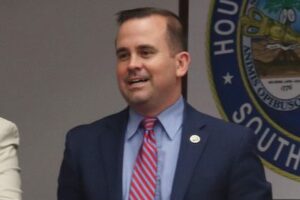
Rep. Neal Collins told an emotional story about the real-life fallout of the “Foetal Heartbeat Bill” he had supported, which prevented a 19-year-old whose water broke at 15 weeks from terminating a pregnancy that was not viable. She was sent home from the hospital with a greater than 50 percent chance of losing her uterus, he said, and a 10 percent chance of developing sepsis and dying.
“That weighs on me. I voted for that bill,” Collins said in a video clip that circulated on social media. “These are affecting people.”
The clip was picked up by CNN Politics, where commentator and former Trump aide Alyssa Farah Griffin said that in some states, the GOP was going too far with abortion restrictions.
“This very extreme position will backfire on Republicans — not having exceptions for rape, incest and life of the mother — and I absolutely think we need to course-correct,” she said.
That’s the view of many political observers who are rewriting their predicted narratives for the midterm elections since voters began having their say at actual ballot boxes. A special election victory by Congressional candidate Pat Ryan — a New York Democrat who campaigned on abortion rights after the Supreme Court struck down Roe v. Wade — is a sign that Democrats are now more competitive in the midterms than anticipated.
Anger over the abortion ruling is translating into new voter registration and could fuel a pushback at the ballot box, several new analyses suggested.
Tom Bonier, CEO of the political data firm TargetSmart, dug deep into Ohio voter registration and reported that women out-registered men by an 11 percentage-point margin since the Supreme Court’s Dobbs decision on June 24 — a huge change from the 2018 midterms.
Bonier documented the surge of women who registered to vote in Kansas after the leak of the Supreme Court’s draft ruling in early May before Kansans voted overwhelmingly to preserve abortion rights in the state’s first-in-the-nation referendum on the issue.
Not to be outdone, the New York Times’ The Upshot examined new voter registration in 10 states and found the number of women registering to vote rose by about 35 percent after the decision was leaked, while men had an uptick of 9 percent.
Meanwhile, abortion bans have taken effect in 12 states. But in one of those, Idaho, the Justice Department prevailed in a legal challenge that partially blocked criminal prosecution of doctors who perform abortions. A federal judge agreed with the Justice Department that Idaho’s abortion ban conflicts with the federal Emergency Medical Treatment and Labor Act, which requires hospitals that receive federal funding to provide treatment in medical emergencies.
In Texas, the decision was the exact opposite. A federal judge agreed with Attorney General Ken Paxton that the state can’t be compelled by the federal government to save a pregnant woman’s life with an abortion.
In other news
Once vulnerable, N.H. Senator Maggie Hassan is suddenly benefiting from abortion ruling, other Democratic breaks – The Boston Globe.
Google, criticized for steering those search for abortion to anti-abortion crisis pregnancy centres, takes steps toward clarity – Bloomberg
The aforementioned HBO series “House of the Dragon,” which requires both trigger and spoiler alerts for a brutal childbirth scene that was upsetting to many women.
Still, one of the showrunners told the L.A. Times that the women consulted during production offered positive feedback. “Some felt it wasn’t violent enough,” he said.
Was it gratuitous – as was often said about its patriarchal forebear “Game of Thrones?” Was it transparent in its intentions, like a latter-season “Handmaid’s Tale”? I was surprised to discover it was written and filmed well before the Supreme Court ruling.
Mouse whisper
Appalling taste. According to The Economist, there are those Brits who are promoting Larry the Cat as the next British Prime Minister. Extraordinary how the Brits have embraced this serial murine killer. But then Larry has had to deal with Boris Knotgudonov, who has tried to portray himself as a cool cat, but turned out to be an appalling mouser.
